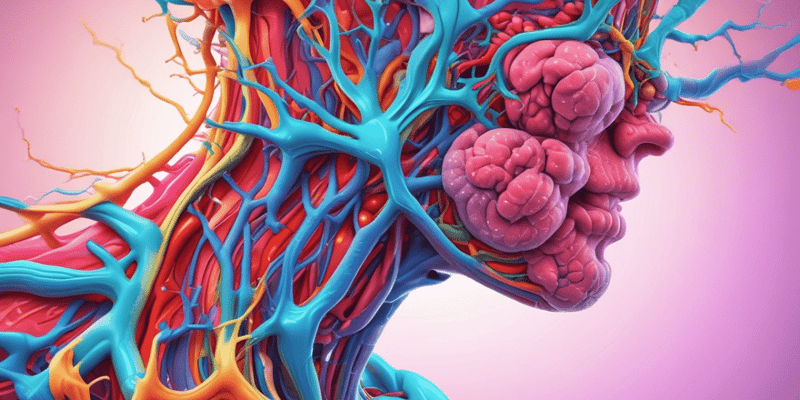Podcast Beta
Questions and Answers
What is the primary function of target cells in the endocrine system?
Which characteristic differentiates endocrine glands from exocrine glands?
Which statement about steroid hormones is true?
What is the approximate size of the pituitary gland compared to other glands in the endocrine system?
Signup and view all the answers
Which of the following correctly describes the synthesis of nonsteroid hormones?
Signup and view all the answers
What role does the hypothalamus play in relation to the pituitary gland?
Signup and view all the answers
Which hormone produced by the anterior pituitary directly stimulates milk production in females?
Signup and view all the answers
What is the effect of hypersecretion of growth hormones in individuals whose epiphyseal plates have already fused?
Signup and view all the answers
What is the role of follicle-stimulating hormone (FSH) in the male reproductive system?
Signup and view all the answers
Which pituitary hormone is responsible for stimulating the adrenal cortex to secrete corticosteroids?
Signup and view all the answers
What is the primary function of thyroid-stimulating hormone (TSH)?
Signup and view all the answers
Which condition is characterized by excessive skeletal growth due to hypersecretion?
Signup and view all the answers
Hyposecretion of growth hormones primarily leads to which of the following conditions?
Signup and view all the answers
What is the primary consequence of hyposecretion of growth hormone during childhood?
Signup and view all the answers
What function does Antidiuretic Hormone (ADH) primarily serve?
Signup and view all the answers
Which part of the pituitary gland is composed of neural tissue?
Signup and view all the answers
What triggers the release of milk from the breasts during lactation?
Signup and view all the answers
Which glandular tissue secretes corticosteroids?
Signup and view all the answers
What is a primary function of calcitonin in relation to calcium levels?
Signup and view all the answers
During which part of the menstrual cycle is Luteinizing Hormone (LH) most likely to surge?
Signup and view all the answers
What do parathyroid hormones primarily do when blood calcium levels are low?
Signup and view all the answers
Which condition is characterized by not having enough calcium in the blood?
Signup and view all the answers
What type of hormones are epinephrine and norepinephrine categorized as?
Signup and view all the answers
What is the role of the adrenal medulla?
Signup and view all the answers
What effect does a drop in blood calcium levels of as small as 1% have on parathyroid hormone secretion?
Signup and view all the answers
In terms of metabolism, what condition is associated with hypersecretion of thyroid hormones?
Signup and view all the answers
What is the principal mineralocorticoid and its primary function?
Signup and view all the answers
Which of the following is NOT a symptom of Cushing syndrome?
Signup and view all the answers
How does cortisol help the body during stressful situations?
Signup and view all the answers
Which effect does aldosterone primarily have on the kidneys?
Signup and view all the answers
In women, the hypersecretion of adrenal androgens due to conditions like Cushing syndrome can lead to which of the following?
Signup and view all the answers
What consequence does the retention of sodium and water due to excess cortisol lead to?
Signup and view all the answers
What role do glucocorticoids play in the immune system?
Signup and view all the answers
What is one of the main consequences of the breakdown of protein as a result of cortisol's action?
Signup and view all the answers
Which of the following is a common characteristic of glucocorticoids like cortisol?
Signup and view all the answers
What classic physical feature is associated with Cushing syndrome?
Signup and view all the answers
What is primarily affected in Addison Disease?
Signup and view all the answers
What is the role of melatonin produced by the pineal gland?
Signup and view all the answers
Which hormones are secreted by the thymus gland?
Signup and view all the answers
What structural characteristic distinguishes the thyroid gland?
Signup and view all the answers
When does the thymus gland begin to shrink?
Signup and view all the answers
What risk is associated with excessively high levels of melatonin?
Signup and view all the answers
What is the anatomical location of the thymus gland?
Signup and view all the answers
What consequence can occur without treatment of Addison Disease?
Signup and view all the answers
How do the levels of melatonin fluctuate throughout the day?
Signup and view all the answers
What happens to the thymus gland as one ages?
Signup and view all the answers
Study Notes
Endocrine System Overview
- Comprises various glands and specialized cells that secrete hormones into the bloodstream.
- Hormones are chemical messengers that regulate numerous bodily functions.
Target Cells
- Target cells possess specific receptors for particular hormones.
- Hormones travel through the bloodstream, affecting only those cells with compatible receptors.
Endocrine vs. Exocrine Glands
- Endocrine glands release hormones directly into the bloodstream.
- Exocrine glands have ducts that transport substances to external environments.
Hormones Classification
- Steroid hormones are derived from cholesterol, including sex hormones and aldosterone.
- Nonsteroid hormones are protein-based and synthesized from amino acids.
Pituitary Gland and Hypothalamus
- Pituitary gland: the most influential endocrine gland, located beneath the hypothalamus.
- Consists of two parts: anterior pituitary (glandular tissue) and posterior pituitary (neural tissue).
Anterior Pituitary Function
- Produces essential hormones such as:
- TSH: Stimulates thyroid hormone secretion.
- Prolactin: Promotes milk production.
- ACTH: Stimulates adrenal cortex to release corticosteroids.
- GH: Promotes growth and protein synthesis.
- LH: Stimulates ovulation and estrogen secretion.
- FSH: Stimulates egg and sperm production.
Growth Hormone Regulation
- Hypersecretion leads to gigantism in children or acromegaly in adults.
- Hyposecretion causes pituitary dwarfism during childhood.
Posterior Pituitary Hormones
- Stores and releases hormones from the hypothalamus:
- ADH: Regulates water retention in kidneys.
- Oxytocin: Stimulates uterine contractions and milk ejection.
Adrenal Glands
- Located atop each kidney, consisting of:
- Adrenal Medulla: Secretes catecholamines (epinephrine and norepinephrine).
- Adrenal Cortex: Secretes corticosteroids, including mineralocorticoids and glucocorticoids.
Corticosteroid Functions
- Mineralocorticoids (e.g., aldosterone): Promote sodium retention and potassium excretion, leading to water retention.
- Glucocorticoids (e.g., cortisol): Aid in stress adaptation; break down fats/proteins to glucose; anti-inflammatory properties.
Adrenal Disorders
- Cushing Syndrome: Excess cortisol leads to symptoms such as obesity, hypertension, and muscle wasting.
- Addison Disease: Life-threatening hyposecretion of adrenal hormones.
Pineal Gland
- Produces melatonin, regulating sleep-wake cycles; levels rise at night and decrease during the day.
Thymus Gland
- Secretes thymosin and thymopoietin, important for immune system development.
- Largest in children, shrinks with age.
Thyroid Gland
- Largest endocrine gland, produces T3, T4, and calcitonin.
- Calcitonin lowers blood calcium levels by promoting calcium deposition in bones.
Parathyroid Glands
- Embedded in the thyroid; secrete parathyroid hormone (PTH) to raise blood calcium levels by mobilizing calcium from bones.
Calcium Homeostasis
- Normal blood calcium levels range from 8.4 to 10.4 mg/dL.
- Hypocalcemia: Symptoms include muscle spasms and tetany.
- Hypercalcemia: Symptoms include muscle weakness and potential cardiac arrest.
Pancreas
- Functions as both endocrine (insulin, glucagon) and exocrine gland (digestive enzymes).
- Regulates blood glucose levels through secretion of insulin (lowers glucose) and glucagon (raises glucose).
Diabetes
- Type 1 Diabetes: An autoimmune condition leading to insulin deficiency.
- Gestational Diabetes: Occurs during pregnancy, often resolves post-birth but increases type 2 diabetes risk.
- Associated complications: nerve damage and cardiovascular issues.
Studying That Suits You
Use AI to generate personalized quizzes and flashcards to suit your learning preferences.
Description
Explore the key components of the endocrine system and understand how hormones interact with target cells. This quiz delves into the functions of various glands and the importance of specific hormone receptors in the body. Test your knowledge on the intricate workings of hormonal communication.




